1993 CHEVROLET ASTRO PASSENGER parking brake
[x] Cancel search: parking brakePage 221 of 345
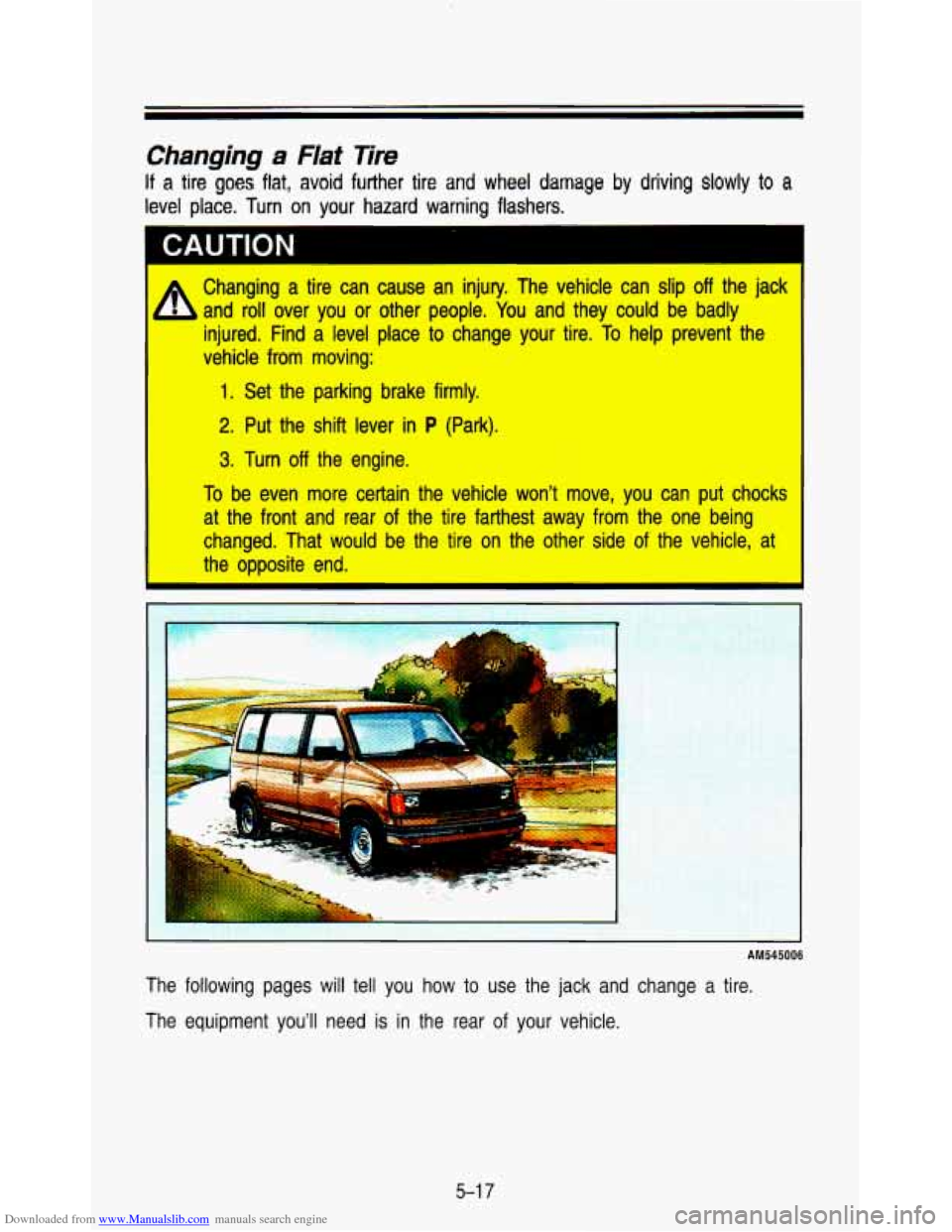
Downloaded from www.Manualslib.com manuals search engine Changing a Flat Tire
If a tire goes flat, avoid further tire and wheel damage by driving slowly to a
level place. Turn on your hazard warning flashers.
I CAUTION
4
Changing a tire can cause an injury. The vehicle can slip off the jack
and
roll over you or other people. You and they could be badly
injured. Find a level place
to change your tire. To help prevent the
vehicle from moving:
1. Set the parking brake firmly.
2. Put the shift lever in P (Park).
3. Turn off the engine.
To be even more certain the vehicle won’t move, you can put chocks
at the front and rear of the tire farthest away
from the one being
changed. That would be the tire on the other side
of the vehicle, at
the opposite end.
I
I
AM545006
The following pages will tell you how to use the jack and change a tire.
The equipment you’ll need
is in the rear of your vehicle.
5-1 7
Page 257 of 345

Downloaded from www.Manualslib.com manuals search engine To get the right reading, the fluid should be at normal operating temperature,
which is
180°F to 200°F (82°C to 93°C).
To check transmission fluid hot: Get the vehicle warmed up by driving
about
15 miles (24 km) when outside temperatures are above 50°F (10°C). If
it's colder than 50°F (lO'C), drive the vehicle in D (Third Gear) until the
engine temperature gage moves and then remains steady for ten \
minutes.
Then follow the hot check procedures.
To check transmission fluid cold: A cold check is made after the vehicle
has been sitting for
8 hours or more with the engine off and is used only as
a reference. Let the engine run at idle for
5 minutes if outside temperatures
are
50°F (1 0°C) or more. If it's colder than 50°F (lO"C), you may have to
idle the engine longer.
A hot check must follow when fluid is added during a
cold check.
To check the fluid hot or cold:
Park your vehicle on a level place.
Place the shift lever in P (Park) with the parking brake applied.
With your foot on the brake pedal, move the shift lever throu\
gh each
gear range, pausing for about three seconds in each range. Then,
position the shift lever in
P (Park).
Let the engine run at idle for three minutes or more.
Then, without shutting off the engine, follow these steps:
K3619
6-21
Page 304 of 345

Downloaded from www.Manualslib.com manuals search engine Service & Appearance Care
Fuses and Circuit Breakers Usage
Name
Inst. Lps.
Pwr. Acc.
Horn-Dm.
Gages
Aux. Htr. NC
Stop-Haz.
Tail Lps.
Turn
BIU
Htr. NC
Radio
ECM B
ECM
I
Pwr. Wdo.
Wiper
Brake
Fog Lamps***
DRL**
Pow. Mirrors*
Trailer*
Circuits Protected
Instrument Panel Lamps, Radio Dial
Lamps, Heater Lamps
Power Door Locks, Power Seat
Horn Relay, Digital Clock, Cigarette
Lighter, Dome Lights, Radio Memory,
Glove Box Lamp
Instrument Cluster Gages, Brake
Switch, Audio Alarm, Headlight Switch
Illumination, Ash Tray Illumination,
Cruise Control
Auxiliary Heater-Rear NC
(if equipped)
Stop Lamps, Hazard Flash, Digital
Instrument Cluster
Headlamp Switch, Tail and Parking
Lamps
Direction Signal Flash, Back Up
Lamps
Front Heater
& Air Conditioning
Radio
Engine Control Module
Engine Control Module
Power Windows
Windshield Wiper
Anti-Lock Brake System,
Speedometer
Fog Lamps
Canadian Daytime Running Lights
Power Mirror
Trailer Wirina Harness
Fuse
10 Amp
30 Amp
20 Amp
25 Amp
20 Amp
20 Amp
20 Amp
20 Amp
10 Amp
10 Amp
10 Amp
25 Amp
15 Amp
15 Amp
10 Amp
3 Amp
30 Amr,
Circuit
Breaker
30 Amp
30 Amp
*In-line fuse.
**Canada only.
“*In-line fuse (certain models).
TO007
6-68
Page 314 of 345
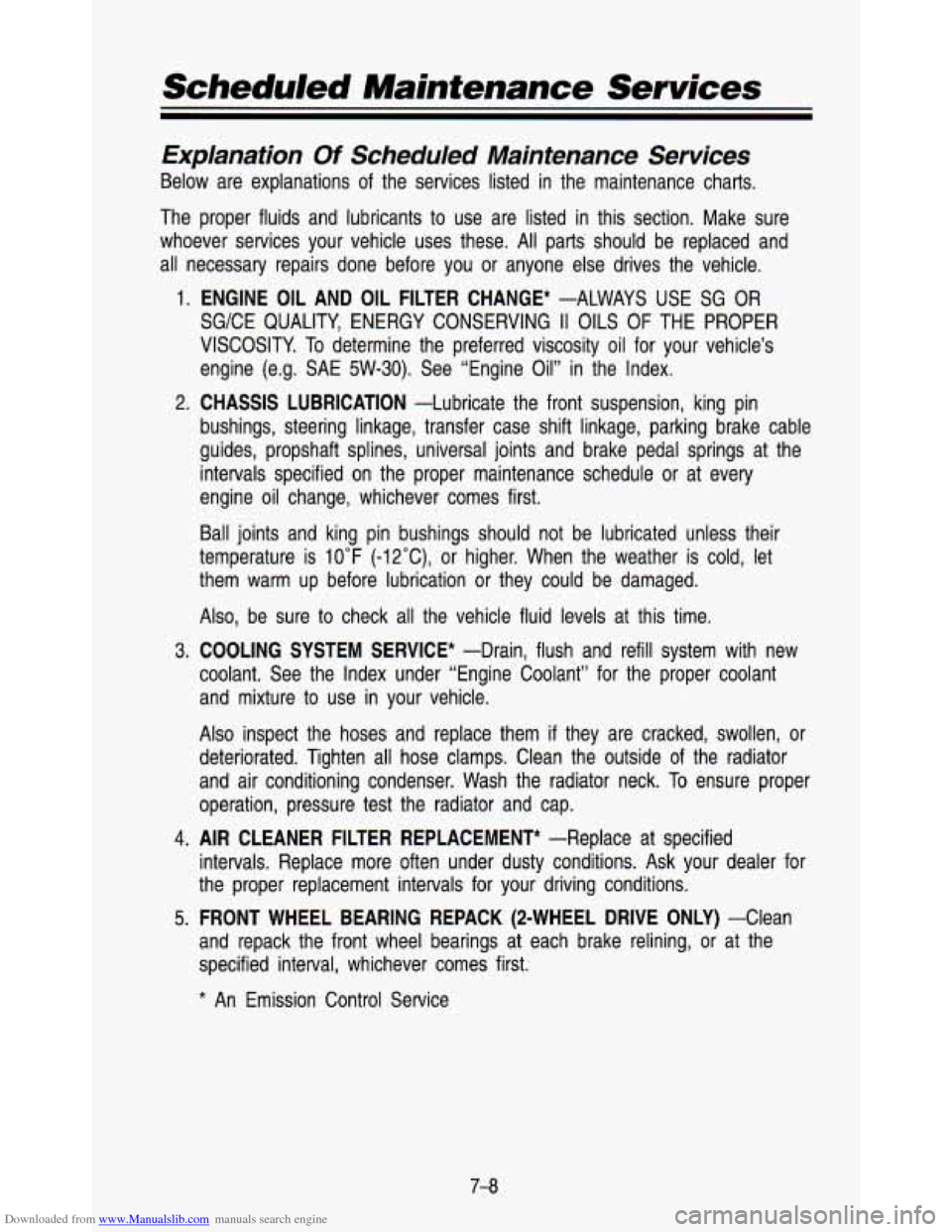
Downloaded from www.Manualslib.com manuals search engine Scheduled Maintenance Services
Explanation Of Scheduled Maintenance Services
Below are explanations of the services listed in the maintenance charts.
The proper fluids and lubricants to use are listed in this section. Make sure
whoever services your vehicle uses these. All parts should be \
replaced and
all necessary repairs done before you or anyone else drives th\
e vehicle.
1. ENGINE OIL AND OIL FILTER CHANGE* -ALWAYS USE SG OR
SG/CE QUALITY, ENERGY CONSERVING II OILS OF THE PROPER
VISCOSITY.
To determine the preferred viscosity oil for your vehicle’s
engine (e.g. SAE 5W-30). See “Engine Oil” in the Index.
bushings, steering linkage, transfer case shift linkage, parking \
brake cable
guides, propshaft splines, universal joints and brake pedal spri\
ngs at the
intervals specified on the proper maintenance schedule or at ev\
ery
engine oil change, whichever comes first.
2.
CHASSIS LUBRICATION -Lubricate the front suspension, king pin
Ball joints and king pin bushings should not be lubricated unl\
ess their
temperature is
10°F (-12”C), or higher. When the weather is cold, let
them warm up before lubrication or they could be damaged.
Also, be sure to check all the vehicle fluid levels at this time.
3.
COOLING SYSTEM SERVICE* -Drain, flush and refill system with new
coolant. See the Index under “Engine Coolant” for the pro\
per coolant and mixture to use in your vehicle.
Also inspect the hoses and replace them
if they are cracked, swollen, or
deteriorated. Tighten all hose clamps. Clean the outside of the radiator
and air conditioning condenser. Wash the radiator neck.
To ensure proper
operation, pressure test the radiator and cap.
4. AIR CLEANER FILTER REPLACEMENT* -Replace at specified
intervals. Replace more often under dusty conditions. Ask your \
dealer for
the proper replacement intervals for your driving conditions.
5. FRONT WHEEL BEARING REPACK (2-WHEEL DRIVE ONLY) -Clean
and repack the front wheel bearings at each brake relining, or at the
specified interval, whichever comes first.
* An Emission Control Service
Page 316 of 345
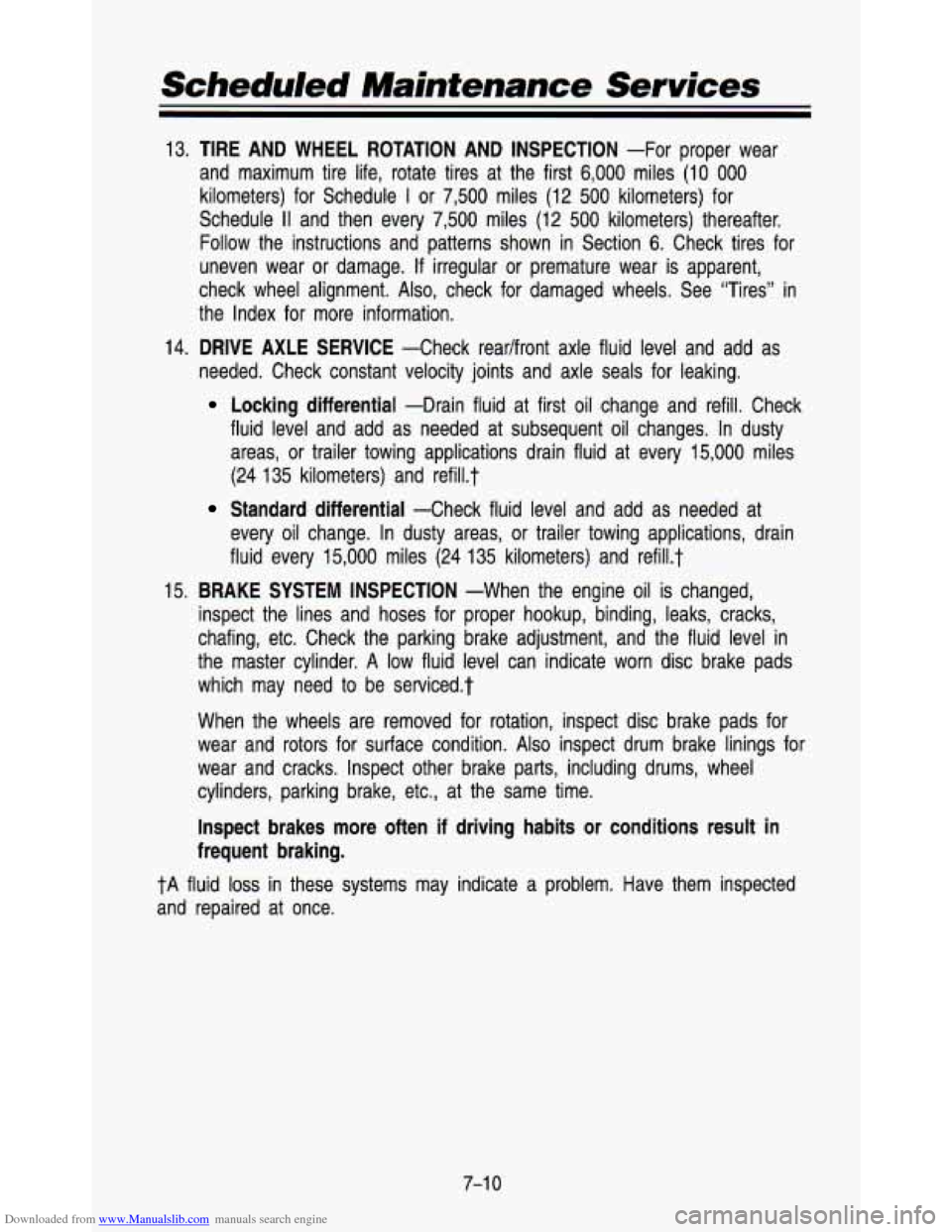
Downloaded from www.Manualslib.com manuals search engine 13. TIRE AND WHEEL ROTATION AN- INSPECTION -For proper wear
and maximum tire life, rotate tires at the first
6,000 miles (1 0 000
kilometers) for Schedule I or 7,500 miles (12 500 kilometers) for
Schedule
II and then every 7,500 miles (12 500 kilometers) thereafter.
Follow the instructions and patterns shown in Section
6. Check tires for
uneven wear or damage.
If irregular or premature wear is apparent,
check wheel alignment.
Also, check for damaged wheels. See “Tires” in
the Index for more information.
14.
DRIVE AXLE SERVICE -Check readfront axle fluid level and add as
needed. Check constant velocity joints and axle seals for leaki\
ng.
Locking differential -Drain fluid at first oil change and refill. Check
fluid level and add as needed at subsequent oil changes. In d\
usty areas, or trailer towing applications drain fluid at every 15,000 miles
(24 135 kilometers) and refi1l.t
Standard differential -Check fluid level and add as needed at
every oil change. In dusty areas, or trailer towing application\
s, drain
fluid every
15,000 miles (24 135 kilometers) and refi1l.t
15.
BRAKE SYSTEM INSPECTION -When the engine oil is changed,
inspect the lines and hoses for proper hookup, binding, leaks, \
cracks,
chafing, etc. Check the parking brake adjustment, and the fluid\
level in
the master cylinder.
A low fluid level can indicate worn disc brake pads
which may need
to be serviced$
When the wheels are removed for rotation, inspect disc brake p\
ads for
wear and rotors for surface condition.
Also inspect drum brake linings for
wear and cracks. Inspect other brake parts, including drums, wh\
eel
cylinders, parking brake, etc., at the same time.
Inspect brakes more often if driving habits or conditions result in
frequent braking.
tA fluid loss in these systems may indicate a problem. Have them inspected
and repaired at once.
7-1 0
Page 317 of 345
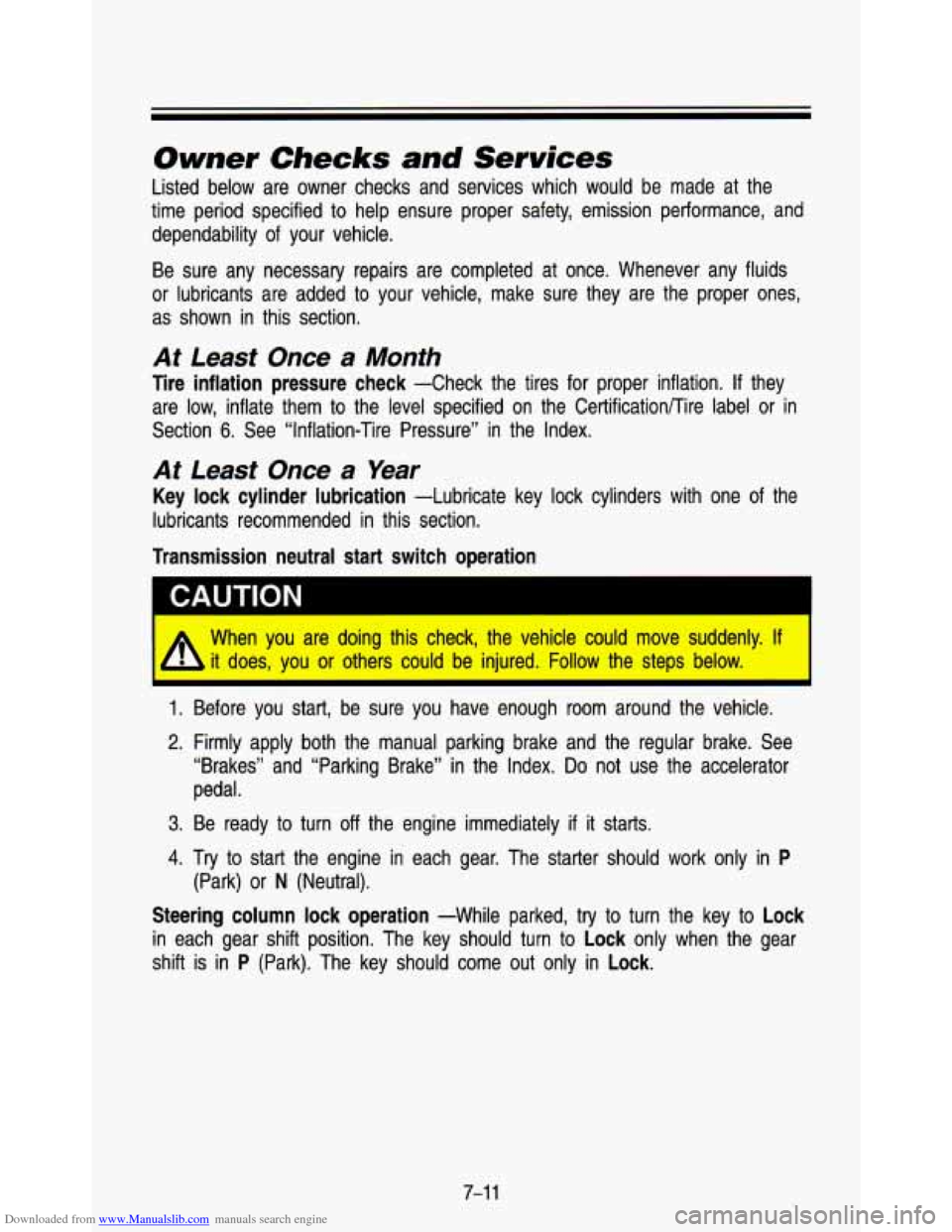
Downloaded from www.Manualslib.com manuals search engine Owner Checks and Services
Listed below are owner checks and services which would be made at the
time period specified to help ensure proper safety, emission performance, and
dependability of your vehicle.
Be sure any necessary repairs are completed at once. Whenever \
any fluids
or lubricants are added to your vehicle, make sure they are the \
proper ones,
as shown in this section.
At Least Once a Month
Tire inflation pressure check -Check the tires for proper inflation. If they
are low, inflate them
to the level specified on the CertificationRire label or in
Section
6. See “Inflation-Tire Pressure” in the Index.
At Least Once a Year
Key lock cylinder lubrication -Lubricate key lock cylinders with one of the
lubricants recommended in this section.
Transmission neutral start switch operation
I A When you are doing this check, the vehicle could move suddenly\
. If I
it does, you or others could be injured. Follow the steps below. I L
1. Before you start, be sure you have enough room around the vehicle.
2. Firmly apply both the manual parking brake and the regular brake. See
“Brakes” and “Parking Brake” in the Index.
Do not use the accelerator
pedal.
3. Be ready to turn off the engine immediately if it starts.
4. Try to start the engine in each gear. The starter should work only in P
Steering column lock operation -While parked, try to turn the key to Lock
in each gear shift position. The key should turn to Lock only when the gear
shift is in
P (Park). The key should come out only in Lock.
(Park) or N (Neutral).
7-1 1
Page 318 of 345
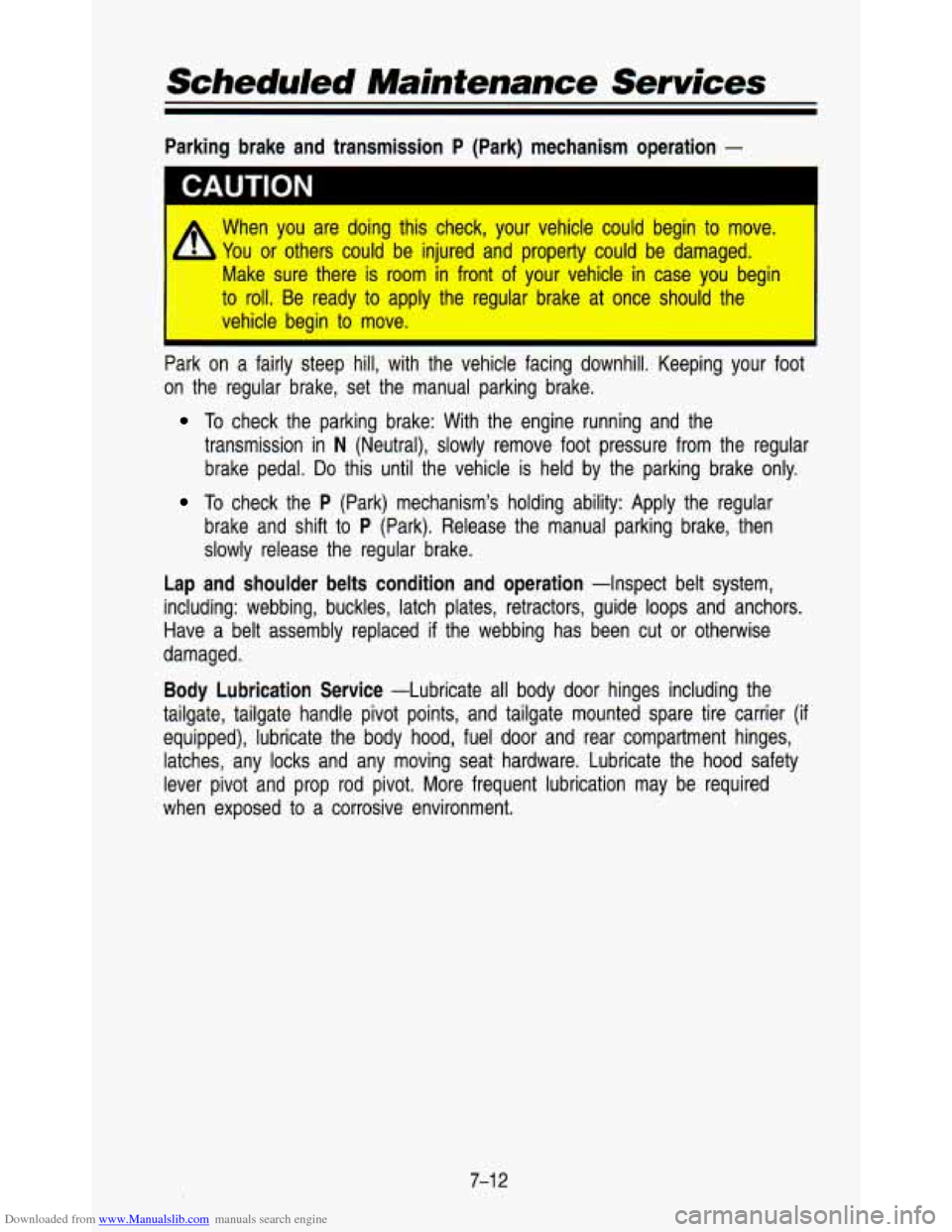
Downloaded from www.Manualslib.com manuals search engine Scheduled Maintenance Services
Parking brake and transmission P (Park) mechanism operation -
I CAUTION
When you are doing this check, your vehicle could begin to mo\
ve. I
/i You or others could be injured and property could be damaged.
Make sure there is room in front of your vehicle in case you\
begin
to roll. Be ready to apply the regular brake at once should the \
vehicle begin to move.
Park on a fairly steep hill, with the vehicle facing downhill.\
Keeping your foot
on the regular brake, set the manual parking brake.
To check the parking brake: With the engine running and the
transmission in
N (Neutral), slowly remove foot pressure from the regular
brake pedal.
Do this until the vehicle is held by the parking brake only.
To check the P (Park) mechanism’s holding ability: Apply the regular
brake and shift to
P (Park). Release the manual parking brake, then
slowly release the regular brake.
Lap and shoulder belts condition and operation -Inspect belt system,
including: webbing, buckles, latch plates, retractors, guide loop\
s and anchors.
Have a belt assembly replaced
if the webbing has been cut or otherwise
damaged.
Body Lubrication Service -Lubricate all body door hinges including the
tailgate, tailgate handle pivot points, and tailgate mounted spa\
re tire carrier
(if
equipped), lubricate the body hood, fuel door and rear compart\
ment hinges, latches, any locks and any moving seat- hardware. Lubricate the\
hood safety
lever pivot and prop rod pivot. More frequent lubrication may \
be required
when exposed to a corrosive environment.
7-1 2
Page 320 of 345
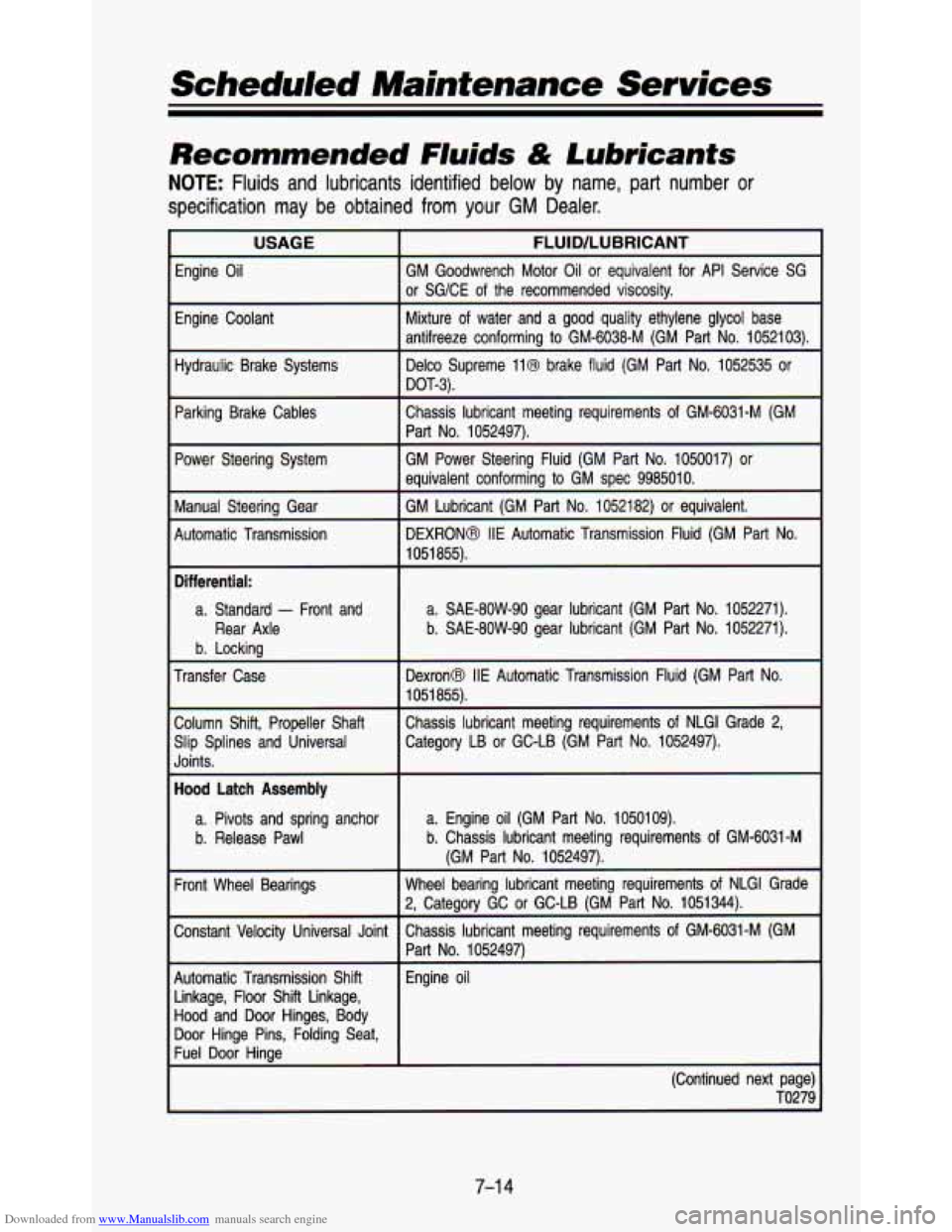
Downloaded from www.Manualslib.com manuals search engine Scheduled Maintenance Services
Recommended Fluids & Lubricants
NOTE: Fluids and lubricants identified below by name, part number or
specification may be obtained from your GM Dealer.
USAGE FLUID/LUBRICANT
Engine Oil GM Goodwrench Motor Oil or equivalent for API Service SG
or SGlCE of the recommended viscositv.
Engine Coolant Mixture
of water and a good quality ethylene
glycol base
antifreeze conforming
to GM-6038-M (GM Part No. 1052103).
Hydraulic Brake Systems Delco Supreme
ll@ brake fluid (GM Part No. 1052535 or
I DOT-3).
Parking Brake Cables Chassis lubricant meeting requirements of GM-6031-M (GM
Part No. 1052497).
Power Steering System GM Power Steering Fluid (GM Part No. 10\
50017) or equivalent conforming
to GM spec 9985010.
Manual Steering Gear GM Lubricant (GM Part No. 1052182) or e\
quivalent.
Automatic Transmission DEXRONB IIE Automatic Transmission Fluid (GM Part No.
~ ~~
1051 855).
Differential:
a. Standard - Front and a. SAE-80W-90 gear lubricant (GM Part No. 1052271).\
Rear Axle
b. SAE-80W-90 gear lubricant (GM Part No. 1052271).
b. Locking
Transfer Case DexronB
IIE Automatic Transmission Fluid (GM Part No.
1051 855).
Column Shift, Propeller Shaft Chassis lubricant meeting requireme\
nts of NLGl Grade
2,
Slip Splines and Universal Category LB or GC-LB (GM Part No. 10524\
97).
Joints.
Hood Latch Assembly
a. Pivots and spring anchor a. Engine oil (GM Part No. 1050109).
b. Release Pawl b. Chassis lubricant meeting requirements of GM-6031-M
Front Wheel Bearings Wheel bearing lubricant meeting requirements\
of NLGl Grade
Constant Velocity
U I Joint Chassis lubricant meeting requirements of GM-6031-M (GM
(GM Part No. 1052497).
2, Category GC or GC-LB (GM Part No. 1051344).
Part
No. 1052497)
Automatic Transmission Shift Engine oil
Linkage, Floor Shift Linkage,
Hood and Door Hinges, Body
Door Hinge Pins, Folding Seat,
Fuel Door Hinge
(Continued next page) TO279
7-1 4